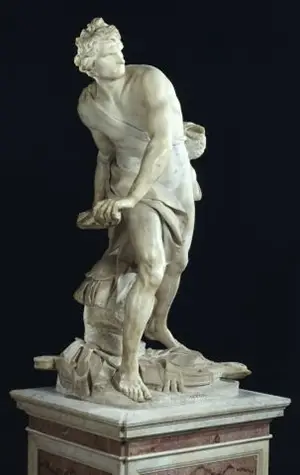 Buy Art Prints Now
Buy Art Prints Nowfrom Amazon
* As an Amazon Associate, and partner with Google Adsense and Ezoic, I earn from qualifying purchases.
David is a marble sculpture created by Gian Lorenzo. The piece was completed between 1623 and 1624, within seven months.
The sculpture was among the various commissions used to decorate Cardinal Scipione Borgese's villa, where it remains up to now as a part of Galleria Borgese. The subject of this masterpiece is the David of the holy bible, just about to throw the stone that will kill Goliath, allowing David to behead the gigantic warrior. David was Bernini's last artwork to be commissioned by Scipione Borgese.
Bernini was commissioned by his patron Cardinal Borghese between the years of 1618-1625 to create sculptures to decorate the Borghese villa. Bernini was only 24 years old when he started working on David (after abandoning another project) and it was the last sculpture commissioned for the Borghese villa.
David by Bernini is a 3-D artwork that requires space around it, and it challenges the viewers to walk around it and also contemplate its flexible nature contingent on the angle from which the piece is seen. This incredible sculpture also relates to an invisible subject in the form of Goliath, who is the object of the aggression of David and to the spectator who is caught in the midst of the conflict as well.
The sculpture illustrates a scene from the book of 1st Samuel in the Old Testament. The Israelites were in a battle with the Philistines whose leader Goliath had challenged the army of Israel to settle the war by a single fight. David, a young shepherd, has taken the challenge and is almost slaying the Philistine with one stone from his sling bag. David struck Goliath on the forehead, and the stone sank deep in his forehead, and he fell on the ground on his face.
David's clothing is entirely the typical shepherd's attire. The armour of Saul, the King of Israel, was given to David and it lies at his feet. David shed the armour since he wasn't accustomed to it. You will also see his harp at his feet, and it's included in the piece as an iconic gadget of David being a talented harpist in the book of Psalms.
Several other items lie about David's feet on the statue. These include armour given to David by Saul who was king of the Israelites. This armour was not worn by David during his battle because he was more accustomed to a shepherd's outfit which was lighter and easier to move in. A harp is also by his feet due to David being a skilled harpist and in connection with David the Psalmist.
The David of the Bible was a common subject among most Renaissance artists and had been treated as such by sculptors like Michelangelo (1501-1504), Verrocchio (1473-1475) and Donatello (c.1440s). Gian Lorenzo's David, although engaging with these sculptures, differed from them in many significant ways. First, the sculpture is not self-contained, though it interacts with the entire space around it. It was not since the Hellenistic period sculptures like the Winged Victory of Samothrace had artworks involved in their surroundings just like those of Bernini. The most likely source of the figure of Bernini was Borghese Gladiator, a Hellenistic sculpture.
The other difference can be seen at the moment that Gian has decided to portray. Michelangelo's David typically differs from those of Verrocchio and Donatello in that it depicts David preparing for war, instead of victorious afterwards. Gian, on the other hand, decided to portray David throwing the stone. That illustrated a novelty since throwing figures were quite rare in other post-Antiquity sculptures. However, the motion motif existed in painting, and one example is the fresco of Cyclops Polyphemus depicted throwing a stone. Gian is likely to have known this sculpture since Bernini ranked Carracci as the fourth among the greatest artists. Other possible influences of Bernini's work include Treatise on Painting, one of the writings of Leonardo da Vinci - though not certain, it is probable that Bernini studied Leonardo Da Vinci's writings before he created David. Da Vinci wrote about portraying a figure throwing in artwork in his Treatise of Painting.
Despite being used so often, Bernini's sculpture was innovative due to David moving and interacting with his space rather than captured in a pose. Bernini also portrayed David during his battle with Goliath as opposed to the popular scene of David in victory.
Baroque changed a lot from the Renaissance. What was first only one dimensional became three dimensional (particularly in Bernini's David) which requires the viewer to walk about the artwork and contemplate it from all sides. The statue also challenges space itself with David's foot over the very border of the plinth that he is stood upon. Time was also challenged because David is caught within a moment of motion as opposed to being stationary.



